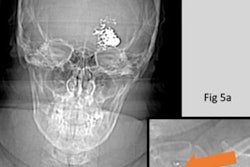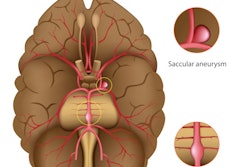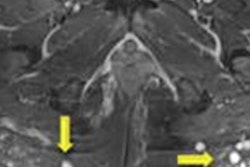
A six-year study conducted at a top London facility that involved nearly 600 scans on more than 300 patients has found that the risk of a tattoo-related adverse event occurring during 3-tesla MRI is less than 1%.
"One volunteer reported a warm and tight feeling around the tattoo that was classified as a mild tattoo-related adverse reaction," explained lead presenter Martina Callaghan, PhD, head of physics at the Wellcome Centre for Human Neuroimaging at the University College London (UCL) Institute of Neurology in London.
"This occurred at the outset of scanning, during the localizer sequence, at which point scanning was terminated. No medical intervention was required and the event resolved naturally over the course of a day with no residual effect," she told attendees at the annual meeting of the International Society for Magnetic Resonance in Medicine (ISMRM 2018) in Paris.
Tattoos are recognized as a potential source of increased risk for MRI, and there have been isolated reports of adverse effects such as radiofrequency (RF)-induced heating or pigment-specific magnetic force in the absence of scanning, she continued.
Lack of consistent guidelines
Despite the potential risks and increased prevalence of tattoos, guidelines remain inconsistent across sites due to the scarcity of information available on the topic and also the complexity of the situation. Tattoos vary extensively, making it extremely difficult to characterize via modeling the potential modes of interaction with the MRI environment, Callaghan and colleagues added.
A potential approach is to quantify any increase in risk resulting from tattoos. For instance, one retrospective, questionnaire-based study gave details about two reports of potential incidents from 135 participants who had undergone MRI (Journal of Magnetic Resonance Imaging, February 2002, Vol. 15:2, pp. 180-184), but retrospective approaches are limited by biased outcome reporting and not having consistent descriptors of events and exam conditions, they stated.
The goal of the UCL group's prospective study was to establish whether tattoos increase the risk of an adverse reaction during MRI, and, if so, to identify any potential risk factors. All imaging was performed at 3 tesla, and to minimize potential risks, the scanner was operated in normal mode, limiting the maximum whole-body specific absorption rate (SAR) to 2 W/kg and thereby limiting energy absorption.
Volunteers with one or more tattoos were recruited with the following inclusion criteria:
- No tattoo on the head, neck, or genitals
- No thermoregulatory or skin insensitivity problems at the site of the tattoo(s)
- Longest dimension of tattoo(s) less than 20 cm
- No more than 5% of the total body area covered
- Tattoos at least 20 cm apart (or otherwise treated as a single tattoo)
- Informed written consent obtained
The scans were conducted between November 2011 and October 2017, using the Allegra (n = 17), Trio (n = 551), and Prisma (n = 5) systems from Siemens Healthineers, equipped with either a body coil (n = 555) or transmit-receive head coil (n = 18) for RF transmission. A broad range of data was acquired, including sequences for both functional and anatomical imaging. The maximum SAR recorded ranged from 4% to 95% (median ± interquartile range [IQR] = 36 ± 15%).
The median age at the time of scanning was 27 (IQR 10 years). The number of tattoos per participant ranged from one to six, with 900 unique tattoos examined across the cohort. The tattoos were applied with black (most prominent), red, yellow, blue, white, orange, green, violet, brown, gray, and turquoise inks. They ranged in size from 0.5 cm to 20 cm and were applied primarily in Europe (547; 433 of these in the U.K.) but also in the U.S., Asia, Africa, and Australia.
Based on the occurrence of one adverse reaction in 573, the probability of an adverse reaction was estimated to be less than 0.97% (95% confidence interval), Callaghan reported.
This conclusion is based on participants recruited to cognitive neuroscience studies in the first instance and is not expected to be indicative of the U.K. population as a whole, but it is perhaps typical of a neuroimaging cohort in a city such as London, she noted. Additional safety precautions were implemented, such as limiting tattoo size, their location, and their extent across the body. What's more, the characteristics of the tattoo may influence the risk of an adverse effect -- a wide range of inks are used -- but these are not well-regulated.
Finally, this study was conducted at 3 tesla, and the findings may not necessarily apply to other field strengths.
7T scans of patients with tattoos & implants
In another e-poster presentation at ISMRM 2018, German researchers shared their experiences of 7-tesla MRI of human subjects with passive implants and tattoos.
They retrospectively analyzed questionnaires and screening forms to identify all subjects with implants and/or tattoos cleared for imaging on a 7-tesla whole-body MR unit. Over 11 years, 496 out of 2,370 healthy volunteers and volunteers with known pathologies had implants and/or tattoos. None of the subjects reported any discomfort related to heating or force during or after imaging, and no safety concerns were reported.
"The latest generation of 7-tesla MR systems is currently emerging as a diagnostic modality for neuroradiology and musculoskeletal imaging," noted lead author Oliver Kraff, PhD, staff scientist at the Erwin L. Hahn Institute for MRI at the University of Duisburg-Essen in Essen. "Many subjects present with implanted medical devices (IMDs), but almost none has been labeled MR-conditional up to 7-tesla magnetic field strength. Many 7-tesla research centers conservatively exclude all subjects with implants or tattoos, regardless of type or location."
To identify all subjects with implants and/or tattoos cleared for 7-tesla imaging (Magnetom 7T, type 900 passively shielded, Siemens Healthineers), the team studied questionnaires and forms from May 2014 to September 2017. These datasets were added to the results published by the same authors in 2015 to cover a period of 11 years (October 2006 to September 2017).
They examined the types of implants (material, dimension, geometry) and also their location with respect to the exposure volume of the local RF transmit coil of each study. The decision-making process was divided into three categories, as shown below.
| Decision-making process for MRI with implants | ||
| Implant location from local transmit coil | Minimum requirement for decision-making | Rationale |
| > 30 cm distance | Nonmagnetic material (e.g., titanium); 3T MR-conditional labeling | Due to local transmit RF coil, interaction between (stray) RF field and implant may be neglected*, leaving attractive forces and gradient-induced heating as residual concerns. |
| < 30 cm distance | Additional knowledge about typical power deposition of RF coil at location of implant | Total exposure volume of local RF coil is typically larger than its physical dimension; potential interaction of stray field with implant should be investigated. |
| Within direct RF exposure volume | Dedicated safety assessment at 7T | Alteration of SAR distribution and increased maximum local SAR values cannot be excluded and need detailed investigation. |
A distance of 30 cm between an implant and the physical extent of the local RF coil was used to define the categories, as this distance yielded almost no stray RF fields at the location of the implant for the local RF coil. Simplified rules were applied solely for dental implants and tattoos (drawn within the European Union after the year 2000). Most of the subjects were imaged at 1.5 tesla or 3 tesla prior to the 7-tesla examination, according to Kraff and colleagues.
Of the 496 patients, 184 presented with one or several tattoos, and 273 reported one or several implants; 39 patients had both tattoos and implants. For those with implants, the majority had dental implants (230).
Imaging was performed in 82 patients with retainer wires within a head coil. Cranial osteosynthesis plates were present within a head coil in 14 people. In 11 subjects scheduled for head imaging, total endoprostheses were reported for the hip joint (six) and knee joint (five). In one subject with surgical clips within a flexible body coil and in three people with multiple cardiac stents in close proximity to the head coil, clearance for imaging was restricted to low-SAR sequences only.
| Implants list over the past 11 years at Erwin L. Hahn Institute | ||||
| Implant category | Implant type/location | No. of subjects | Cases when IMD was within coil housing | Local transmit coil used |
| Dental implants | Retainers | 89 | 82 | NM: 71; CB: 8 |
| Bridges, crowns | 72 | 69 | NM: 63; CB: 9 | |
| Other | 77 | 66 | NM: 65; CB: 12 | |
| Cranial fixation | Miniplate (Biomet) | 10 | 10 | NM: 3; CB: 7 |
| DY MatrixNeuro (Synthes) | 3 | 3 | NM: 3 | |
| CranioFix (Aesculap) | 1 | 1 | NM: 1 | |
| Stents | Cardiac | 6 | NM: 6 | |
| Femoral, pelvis | 5 | NM: 5 | ||
| Port catheter | NuPort-HP (PHS Medical) | 1 | CB: 1 | |
| Titanium power port (BARD) | 1 | CB: 1 | ||
| Orthopedic implants | Hip TEP | 6 | NM: 6 | |
| Knee TEP | 5 | NM: 5 | ||
| Other (e.g., screws, plates) | 36 | NM: 29; CB: 7 | ||
| Intrauterine devices | Mirena (Bayer Healthcare) | 13 | NM: 13 | |
| NuvaRing (Merck) | 4 | NM: 4 | ||
| Other implanted contraceptives | 9 | NM: 8 | ||
| Miscellaneous | Surgical clips | 4 | 1 | NM: 3; CB: 1 |
| Breast implant | 5 | NM: 4; CB: 1 | ||
| Hernia mesh | 5 | 1 | NM: 4; CB: 1 | |
| Not removable jewelry | 6 | 1 | NM: 5; CB: 1 | |
Because 7-tesla exams are not yet medically indicated and only limited information is available about the safety of implants at 7 tesla, imaging must be performed in carefully selected volunteers and after acquirement and evaluation of substantial information about the implants, the authors wrote.
"The region of interest of the scan should be compared with the exact location of the implant. This is particularly relevant at 7 tesla because only local transmit coils are used and RF heating is more probable in the exposure volume of the RF transmit coil than elsewhere," they noted. "At our institution, a case-by-case decision was made for all subjects with implants, depending on size, geometry, and location of the implant with respect to the RF coil. However, for dental implants and tattoos, a safe history of use has led to a more straightforward inclusion criteria."
They believe the exclusion of all subjects with implants from 7-tesla exams should not be compulsory, and the examination of certain subjects with implants can be performed after careful evaluation of implant type and location.


















